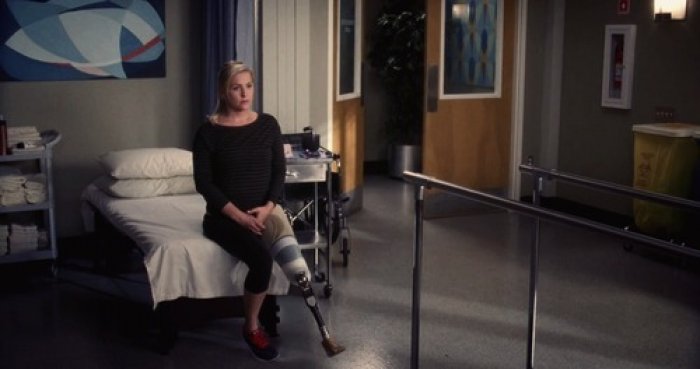This guest post written by Madison Zehmer appears as part of our theme week on Unpopular Opinions.
[Trigger warning: discussion of rape, trauma, and PTSD]
Shonda Rhimes, the creator of Grey’s Anatomy, Scandal, and How to Get Away with Murder, is known for putting her characters in unpredictable, shocking, and even tragic situations. Over the course of Grey’s Anatomy’s 13 seasons, the surgeons of Grey-Sloan Memorial Hospital have faced a bomb explosion, a shooting, a plane crash, and multiple car crashes. Major characters, including Derek Shepherd, Mark Sloan, George O’Malley, and Lexie Grey, have been killed, and others have experienced serious physical and mental health problems as a result of the tragedies they have endured.
Because Rhimes and the writers of Grey’s Anatomy choose to put their characters in situations that in real life would yield enormous consequences, the writers arguably have a responsibility to portray the character’s responses to these events as realistically and honestly as possible. The writers also have to be careful not to exploit serious issues, such as posttraumatic stress disorder (PTSD), for the sole purpose of entertainment. Dr. Arizona Robbins’ (Jessica Capshaw) leg injury, amputation, and subsequent PTSD in seasons 9 and 10 of Grey’s Anatomy was depicted for shock value and entertainment. As a result, the narrative surrounding Arizona’s recovery is insufficient and flawed, ignoring the extent of the real mental health challenges she faces, ultimately blaming Arizona for her inability to completely recover mentally and emotionally from the trauma she experiences.
The plane crash at the end of season 8 of Grey’s Anatomy leaves two surgeons dead and the other four wounded. Arizona, a bubbly, lesbian, pediatric surgeon, suffers a serious injury to her left thigh. When the surviving surgeons are rescued after 4 days in the woods, the doctors that treat the survivors in the immediate aftermath recommend that Arizona undergo an amputation of the majority of her left leg. She refuses and goes back to Seattle, where her wife, orthopedic surgeon Dr. Callie Torres (Sara Ramirez), attempts to treat the infection in the wound without resorting to amputation. When Arizona began to go into septic shock while Callie is operating on Dr. Derek Shepherd’s injured hand, Callie reluctantly gives Dr. Alex Karev permission to amputate Arizona’s leg, knowing that Arizona would die without the procedure.
Over the course of a couple of weeks, Arizona’s life changes dramatically. Before the plane accident, she is an able-bodied, characteristically joyful mom and surgeon in a relatively happy marriage. The wreck, serious infection, and amputation greatly restrict her ability to function the way she had before the accident; the aspects of her life that she deems to be most important no longer seem to be guaranteed. Arizona begins to question whether she will be able to perform surgeries and adequately take care of her child in the future. As she is extremely angry at Callie because she believes Callie amputated her leg, she resists her wife’s efforts to help her and to motivate her.
In the wake of the accident, Arizona develops a flat affect and stops communicating with her friends and her wife. This is especially striking, because prior to the accident she was the token “happy” character on Grey’s Anatomy, known for her enthusiasm and cheer in less than ideal situations. In addition to a blunted affect, Arizona experiences multiple symptoms of PTSD after the accident, including outbursts of anger, nightmares, panic attacks, and impulsive behavior.
Because of the brain’s plasticity, traumatic events often cause connections in the brain to “rewire,” which can cause the dysregulation of Cortisol (often called the “stress hormone”) and other hormones and neurotransmitters and the reduction of hippocampal volume, among other neurological changes. PTSD is a mental disorder that is helped by medical treatment (medication, counselling, therapy), just like other disorders or illnesses.
Although Arizona clearly suffers from many of the symptoms of PTSD, she does not receive any psychiatric treatment or therapy. Since her wife and the majority of her friends are medical doctors, it is surprising that they do not suggest that she pursue treatment and that none of the plane crash survivors receive therapy. As Grey’s Anatomy has set a precedent of characters going to therapy (Meredith in season 3, Owen and Cristina in season 6), it is concerning that the writers chose to ignore that aspect of Arizona’s (and Cristina’s, Meredith’s, and Derek’s) recovery.
Additionally, Callie’s and Arizona’s exchange in the first episode of season 9 is unsettling, demonstrating the attitude towards Arizona’s mental health that the show seems to take. Callie walks into their bedroom to find Arizona lying in a hospital bed, faced away from the door. Callie yells at Arizona to, “Get the hell out of bed and snap out of this!” Arizona turns to face Callie and replies as she pulls back a blanket to reveal her amputated leg, “Snap out of this?” Although it’s not inherently problematic for the series to show this exchange, it’s troublesome that they chose to perpetuate the idea that Arizona should have just “gotten over” her trauma without therapy. It’s also problematic that the writers used this scene to reveal the fact that Arizona had lost her leg, suggesting that the choice to put her character through this ordeal was for shock value.
In season 4, episode 7 of the Grey’s Anatomy spinoff Private Practice, Dr. Charlotte King is raped in her office by a patient. Although there are significant problems with this storyline (the rapist is a mentally unstable man who is a stranger to Charlotte, which perpetuates false stereotypes about rape and stigma surrounding mental illness), the Private Practice writers do a significantly better job in regards to the careful depiction of PTSD. KaDee Strickland, the actress who played Charlotte, Rhimes, and the writers consulted the Rape, Abuse, and Incest National Network (RAINN) to realistically depict the aftermath of Charlotte’s rape with care and sensitivity. Strickland agreed to the storyline only after being assured that the aftermath would be handled realistically and the trauma would not be forgotten in a couple of episodes. The impact of the trauma on Charlotte is clear and visible, if not always explicitly stated, for the rest of the show’s duration. In addition, Private Practice and RAINN released a PSA for rape survivors. Charlotte’s recovery is depicted with care and discernment, demonstrating that the writers are aware of the responsibility they have to ensure that the storyline does not exploit trauma for shock value or for entertainment.
If the Grey’s Anatomy writers had treated Arizona’s storyline in seasons 9 and 10 with the same sense of sensitivity and responsibility in approaching PTSD that the Private Practice writers treated Charlotte’s storyline, they would have been able to portray a significant issue often overlooked in media in a realistic and respectable way. However, Arizona’s amputation seems to serve as a plot device to create shock and tension in Callie’s and Arizona’s relationship.
Before the accident, Arizona already has a difficult time expressing her emotions. Her PTSD and resentment for Callie in the wake of the accident amplifies her tendency to keep her problems to herself. After she suffers from a miscarriage (only shown in flashback scenes) that also seems to exploit Arizona’s grief and feeling of a loss of control for shock value, Arizona ultimately ends up cheating on Callie with a visiting surgeon in the season finale of season 9.
It’s wrong for Arizona to cheat on Callie. However, the way Arizona is depicted in an extremely negative light for the beginning of season 10 paints Arizona as some sort of cold-hearted villain and Callie as the helpless victim. This is a gross over-simplification of the complicated problems in their relationship and the factors leading up to the infidelity, including Arizona’s amputation and PTSD (of which impulsive behavior is a symptom), Callie’s repeated insistence that Arizona “get over” the accident. Arizona and Callie end up getting back together for a short time and going to couple’s therapy (which – again – highlights that Arizona did not receive therapy in the wake of the plane crash) before ultimately deciding to divorce. Now in season 13, Arizona’s personality is very similar to her personality before the crash. Although this is probably ideal for many fans, the show now tends to overlook the fact that Arizona has a disability, erasing part of her identity, only bringing it up back again when it can add to the drama of the show.
The depiction of trauma in media can be very powerful and informative when done correctly. However, when trauma is exploited to shock the audience and create drama, the film or television series often ends up perpetuating dangerous ideas surrounding trauma. Arizona’s recovery from an amputation in the wake of a plane crash could have depicted PTSD honestly and explored issues people with disabilities face, but the storyline mostly just serves to advance the drama that Grey’s Anatomy is known for.
See also at Bitch Flicks:
Interracial Relationships on Grey’s Anatomy
A Love Letter to Dr. Callie Torres on Grey’s Anatomy
Being the Sun: Women and Power in Grey’s Anatomy Season 11
Madison Zehmer is a first-year student at Wake Forest University, where she studies psychology on the pre-med track. She enjoys writing in her spare time. You can find her at Twitter @maddieemz, where she mostly talks about politics and her love for cats.









